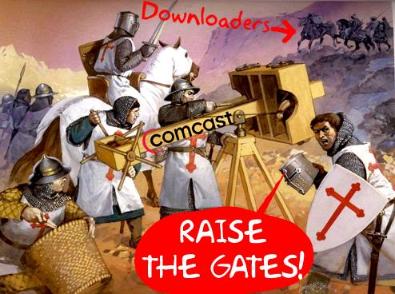Comcastic Broadband Cap Has Net Geeks Up In Arms! – Shelly Palmer Report

Here’s a knee-slapper: “What did Comcast just say to its broadband customers?” Answer: “250GB of data per month ought to be enough bandwidth for anyone!” Get it? Sorry, it’s an inside joke.
In response to getting busted by the FCC for illegally throttling consumer Internet traffic, Comcast put a 250GB per billing cycle cap on consumer bandwidth. What does that mean? To exceed the 250GB cap you would need to watch about eight hours of online video every day for a month. Not likely, you say … perhaps. But, the International Data Corporation found that 81% of Americans questioned do not like the idea of establishing a broadband cap. While the sample size is rather small, 787 people, 51% of those asked claimed that they would change providers if their current service tried to enact a broadband cap. It should also be noted that according to John Donovan, CTO of AT&T, “One percent of the company’s customers account for 20% of the network usage; the top five percent account for 40% of the usage.” Other carriers have said that 5% of users can account for anywhere from 40-to-80 percent of bandwidth usage.

Comcast says that the 250GB cap equates to sending more than 50 million plain text emails, downloading 62,500 songs or 125 standard definition films at roughly 2GB each. Considering that the average user downloads roughly 2-3 GB’s per month, the 250GB cap doesn’t seem like it will affect that many people directly. But it will. There are very smart people, like Om Malik from gigaom.com, who have spent some quality time articulating why. Some of his reasons include: the high degree of dependency “interactions” between power users and the rest of the network, the growth trend due to consumers’ changes in content consumption and, the idea that carriers are taking the easy way out trying to protect the “walled garden” rather than figuring out how to innovate in service delivery and harvesting more value from the overall content and applications opportunity.
In its detailed response to the FCC’s August ruling, Comcast says that its "new approach will focus on managing the traffic of those individuals who are using the most bandwidth at times when network congestion threatens subscribers' broadband experience and who are contributing disproportionately to such congestion at those points in time." The Philadelphia-based company tested the new method this summer in five cities across the U.S. and reportedly received zero complaints. Comcast also notes that, according to current usage data, less than one percent of users will be affected by the limit.
While Comcast’s cap is rather generous, for the time being, there are other platforms currently being tested that aren’t so customer friendly. One specific platform is the pay-per-bit offer Time Warner Cable is testing in Texas. The platform test, currently being conducted in Beaumont, TX, offers users a 5GB and a 5-mbps connection for $30/month and 40GB at 15-mbps for $55/month. With consumer cloud services like Apple’s MobileMe and Amazon’s S3 becoming more popular, Netflix movie streaming service rolling out and BitTorrent and private clouds like RapidShare becoming more and more commonplace, it is conceivable that a relatively average consumer who occasionally likes to stream movies from Netflix and download music could exceed the 5GB limit month after month.
Comcast pays about the same amount of money for the bandwidth they sell you as you do. But, there’s a catch. They sell the same connection about 100 times. Have you ever noticed your Internet connection slowing down at peak times when you really need it … like 8pm on a weeknight? It’s because lots of people who have been sold the very bandwidth you have been sold are “contending” for the connection at the same time. Hummm …
When an Internet Service Provider, like Comcast, says that there is too much traffic on the network, you correctly assume that there is an infrastructure problem. But this particular aspect of the infrastructure has very little to do with the network congestion that Comcast is trying to solve with its cap.
It is this dramatic misunderstanding of the network topology that is causing all of the hoopla this week. You’ve got people who live in apartment buildings complaining that the cap is a good thing because it will preserve their network capacity. Wow, is that wrong? A lower over-subscriber ratio would help them right now without a cap.
However, the immortal words of whomever at Comcast said, “250GB of data per month ought to be enough bandwidth for anyone!” will be proven wrong in the long term. We are all going to need way more bandwidth than that. We’re going to want to watch HD video on a bunch of different monitors in different rooms at the same time (just like we watch TV), put our own creative material (including music and video we personally own) on servers in our homes and serve them to ourselves outside of our homes and much, much more. According to Nielsen Media Research, traditional television viewing exceeds eight hours per day per household in the United States. No matter how big our hard drives get, we seem to find stuff to fill them up with. Why should anyone believe that we won’t come up with zillions of ways to use bandwidth?
If we do, how will Comcast (or any provider) handle customers as they embrace all of the new technology being offered? They will do their best as they compete with telephone companies and broadband wireless providers for your bandwidth dollars. Bits and bytes are not dolled out by a monopoly, and if consumers push back hard enough, their dollars will buy what they want from someone.
What about Net Neutrality? That, my friends, is a bridge we’ll jump off when we get to it.
Shelly Palmer is Managing Director of Advanced Media Ventures Group LLC and the author of Television Disrupted: The Transition from Network to Networked TV (2006, Focal Press). Shelly is also President of the National Academy of Television Arts & Sciences, NY (the organization that bestows the coveted Emmy® Awards). He is the Vice-Chairman of the National Academy of Media Arts & Sciences an organization dedicated to education and leadership in the areas of technology, media and entertainment. Palmer also oversees the Advanced Media Technology Emmy® Awards which honors outstanding achievements in the science and technology of advanced media. You can read Shelly’s blog here. Shelly can be reached at shelly@palmer.net
Check out the Shelly Palmer Report archive.


